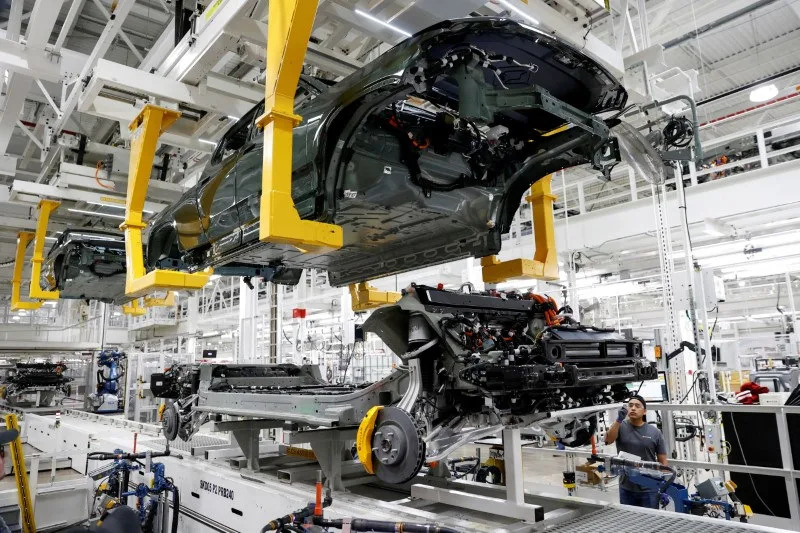Mon, October 2, 2023

FILE PHOTO: Startup Rivian Automotive's electric vehicle factory in Normal
By Lucia Mutikani
WASHINGTON (Reuters) - U.S. manufacturing took a step further towards recovery in September as production picked up and employment rebounded, according to a survey on Monday that also showed prices paid for inputs by factories falling considerably.
The Institute for Supply Management (ISM) said that its manufacturing PMI increased to 49.0 last month, the highest reading since November 2022, from 47.6 in August. Still, September marked the 11th straight month that the PMI remained below 50, which indicates contraction in manufacturing. That is the longest such stretch since the 2007-2009 Great Recession.
"U.S. manufacturing appears to be over the worst, but the outlook remain muted – particularly given the softness of global conditions," said Paul Ashworth, chief North America Economist at Capital Economics in Toronto.
Economists polled by Reuters had forecast the index edging up to 47.7. Five manufacturing industries reported growth last month, including textile mills and primary metals.
Among the 11 industries reporting contraction were computer and electronic products, machinery as well as electrical equipment, appliances and components.
Comments from respondents in the survey continued to be mixed. Makers of transportation equipment said "orders and production remain steady, and we are maintaining a healthy backlog," but cautioned that "continued inflation and wage adjustments continue to drive prices up, although we should get some relief from the markets stabilizing."
Manufacturers of miscellaneous goods said they were keeping an eye on the Panama Canal drought, U.S.-China relations, and the impact the United Auto Workers strike on the supply chains. They, however, viewed overall conditions as "stable."
Apparel, leather and allied products makers described markets as "soft," while primary metals producers said "business conditions and market demand remain strong," and they "projected to be at capacity in the next 12 months."
Stocks on Wall Street were higher. The dollar rose against a basket of currencies. U.S. Treasury prices fell.
NEW ORDERS IMPROVE
While the PMI and other business surveys have painted a grim picture of manufacturing, which accounts for 11.1% of the economy, so-called hard data have suggested that the sector continues to chug along amid higher borrowing costs.
- ADVERTISEMENT -
Orders for long-lasting manufactured goods increased 4.2% year-on-year in August and business spending on equipment appears to have remained strong in the third quarter after rebounding in the April-June period.
The ISM survey's forward-looking new orders sub-index increased to 49.2 last month from 46.8 in August. With new orders improving, production at factories accelerated. The production index increased to 52.5 from 50.0 in the prior month.
Though backlog orders shrank, inventories at factories and their customers remained very low, which should support future production. With demand still weak, prices for factory inputs remained subdued.
The survey's measure of prices paid by manufacturers fell to 43.8 from 48.4 in August. This bodes well for goods deflation, but striking auto workers could boost prices of motor vehicles.
Factory employment improved further after slumping to three-year lows in July. The survey's gauge of factory employment rose to 51.2 last month from 48.5 in August.
A separate report from the Commerce Department showed construction spending increased 0.5% in August after rising 0.9% in July, lifted by outlays on single- and multi-family housing. But with mortgage rates near 23-year highs, momentum could slow.
Construction spending jumped 7.4% on a year-on-year basis in August. Spending on private construction projects rose 0.5%, with investment in residential construction advancing 0.6% after increasing 1.6% in the prior month. Private construction spending gained 1.2% in July.
A dearth of homes available for sale is fueling new construction. The rate on the popular 30-year fixed mortgage averaged 7.31% last week, the highest since December 2000, from 7.19% the prior week, according to data from mortgage finance agency Freddie Mac.
The construction spending report showed outlays on multi-family housing projects rose 0.6% in August. There is limited room for further gains as the stock of multi-family housing under construction is near record highs. Spending on new single-family construction projects rose 1.7%.
Spending on private non-residential structures like factories climbed 0.3% in August. Spending on manufacturing construction projects shot up 1.2%. Efforts by the Biden administration to bring semiconductor manufacturing back to the United States are boosting factory construction.
Spending on public construction projects rebounded 0.6% after dipping 0.1% in July. State and local government spending was unchanged while outlays on federal government projects soared 7.8%.
(Reporting By Lucia Mutikani; Editing by Andrea Ricci)
No comments:
Post a Comment